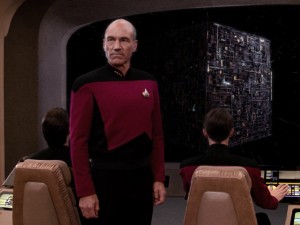HalCon 2016 is the last sizeable convention of the year for me. I normally don’t travel too far for a con, but I have a friend gracious enough to host me for an extended weekend.
It’s the second year I have attended. Size-wise, it’s smaller than Toronto ComiCon held in March and Ottawa ComiCon in May, and on par with London ComiCon held in September.
 For me, who’s attending the con is always a factor for me, and this year’s draw was Gates McFadden, otherwise known as Dr. Beverly Crusher from Star Trek: The Next Generation. At her booth, I asked her why she chose Halifax among all of the other conventions being held during Star Trek’s 50th anniversary. Her answer was the same as LeVar Burton’s when I met him in London, Ontario in September: “I’ve never been here before.”
For me, who’s attending the con is always a factor for me, and this year’s draw was Gates McFadden, otherwise known as Dr. Beverly Crusher from Star Trek: The Next Generation. At her booth, I asked her why she chose Halifax among all of the other conventions being held during Star Trek’s 50th anniversary. Her answer was the same as LeVar Burton’s when I met him in London, Ontario in September: “I’ve never been here before.”
I enjoyed her Q+A panel for the most part, although I waited in line to ask a question the entire session only for it to run out of time. McFadden said it’s only been in recent years she’s been able to really begin to enjoy conventions, having had a stalker years ago while teaching at a university.
Highlights of her chat included how she actually saw herself as a pretty hilarious prankster on the set of TNG, even if cast mates didn’t: Brent Spiner didn’t appreciate her putting Hello Kitty stickers all over his dressing room / trailer, for example. McFadden spoke highly of both David Bowie and Jim Henson while working on Labyrinth as well.
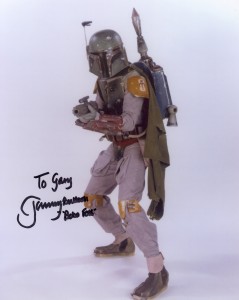 The other guest I was looking forward to was Jeremy Bulloch, who played the original Boba Fett in Star Wars. A well spoken and funny gentleman, he brought up some fans on stage during his panel and even recruited one to help perform Hamlet. Bulloch also appeared in two different Doctor Who stories. His second one, The Time Warrior, marked the first appearance of the Sarah Jane Smith, played by the late Elizabeth Sladen, who was a fan favourite.
The other guest I was looking forward to was Jeremy Bulloch, who played the original Boba Fett in Star Wars. A well spoken and funny gentleman, he brought up some fans on stage during his panel and even recruited one to help perform Hamlet. Bulloch also appeared in two different Doctor Who stories. His second one, The Time Warrior, marked the first appearance of the Sarah Jane Smith, played by the late Elizabeth Sladen, who was a fan favourite.
One thing I’ve found after attending conventions regularly over the last couple of years is that there’s always a guest I didn’t plan to meet who turns out to be a new favourite. Natalia Tena, who played Tonks in the Harry Potter series of films, was very funny. And she’s in a band, too.
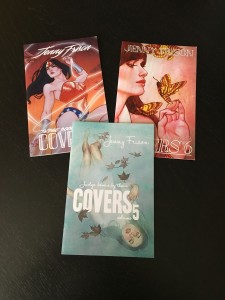 Another pleasant surprise was meeting Jenny Frison, a comic book cover artist and illustrator. I did not realize how many covers of hers I actually owned, but recognized her work immediately. I ended up buying three large prints from her, as well as some of small books showcasing her covers over the years. Frison only does covers, and sees interior art as a different mindset, nothing that some covers by comic book artists that do interior art often end up looking like interior splash pages.
Another pleasant surprise was meeting Jenny Frison, a comic book cover artist and illustrator. I did not realize how many covers of hers I actually owned, but recognized her work immediately. I ended up buying three large prints from her, as well as some of small books showcasing her covers over the years. Frison only does covers, and sees interior art as a different mindset, nothing that some covers by comic book artists that do interior art often end up looking like interior splash pages.
She also talked me into picking up the first collected edition of Revival, written by her brother-her-law, Tim Seeley. I had planned on meeting him so he could sign my first issue of the short-lived yet clever Effigy. Rounding out the trio was Revival artist Mike Norton. They all hail from the Chicago area.
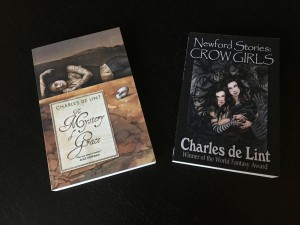 Another writer I’ve always wanted to meet is Charles de Lint, who hails from Ottawa. Over the years he’s even set some of urban fantasy stories in the nation’s capital. I bought a couple of books from him and chatted with him and wife. Canadian writer Julie Czernada was also on hand. I’ve never read her work, but she’s been on my to read list for a while. I had her sign one of her novels I picked up at the Word of the Street festival in September.
Another writer I’ve always wanted to meet is Charles de Lint, who hails from Ottawa. Over the years he’s even set some of urban fantasy stories in the nation’s capital. I bought a couple of books from him and chatted with him and wife. Canadian writer Julie Czernada was also on hand. I’ve never read her work, but she’s been on my to read list for a while. I had her sign one of her novels I picked up at the Word of the Street festival in September.
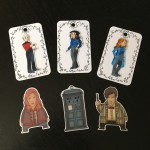 The floor space for vendors and exhibitors is a pretty decent size. For me, it’s a nice change as there are vendors who don’t make it to Ontario. I bought some Doctor Who, Star Wars, Harry Potter and Star Trek fridge magnets from two different local artists, who are friends and have their own art styles. Meanwhile, I did see two Toronto-area artists who I’ve supported in the past and made the trip out to Halifax.
The floor space for vendors and exhibitors is a pretty decent size. For me, it’s a nice change as there are vendors who don’t make it to Ontario. I bought some Doctor Who, Star Wars, Harry Potter and Star Trek fridge magnets from two different local artists, who are friends and have their own art styles. Meanwhile, I did see two Toronto-area artists who I’ve supported in the past and made the trip out to Halifax.
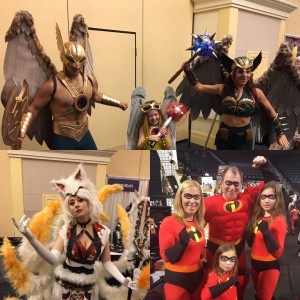 Cosplay, of course, has become a big part of conventions, and last year was the first time I saw cosplayers as invited guests. Toronto-area cons have since followed suit. However, this year, there weren’t many cosplay booths although there so great costumes, including the return of the Incredibles family, and a great Hawk-family.
Cosplay, of course, has become a big part of conventions, and last year was the first time I saw cosplayers as invited guests. Toronto-area cons have since followed suit. However, this year, there weren’t many cosplay booths although there so great costumes, including the return of the Incredibles family, and a great Hawk-family.
HalCon is not a great show for comic books, so while I did manage to get handful of back issues at the convention, I fared better at the local shops, as my friend was also willing to trundle me around. There are six comic book stories in the greater Halifax area, and I was able to hit three. Lower Sackville is home to Cape and Cowl, one of the nicest shops I’ve been to anywhere. It’s struggling, however. I spent a little more than I normally would because I wanted to support the owner. The shop is well-laid out, has a good mix of new and older back issues, as well as toys and collectibles. It also has safe space for the LGBTQ community.
This was the sixth and last sizeable convention of the year for me. There are a couple of one-day comic day shows between now and Christmas here in Toronto, but the next convention for me will be Toronto ComiCon in March. Next year, HalCon will be in late September and in a large facility as the new convention centre in Halifax will be complete, so the show will be a lot different.
